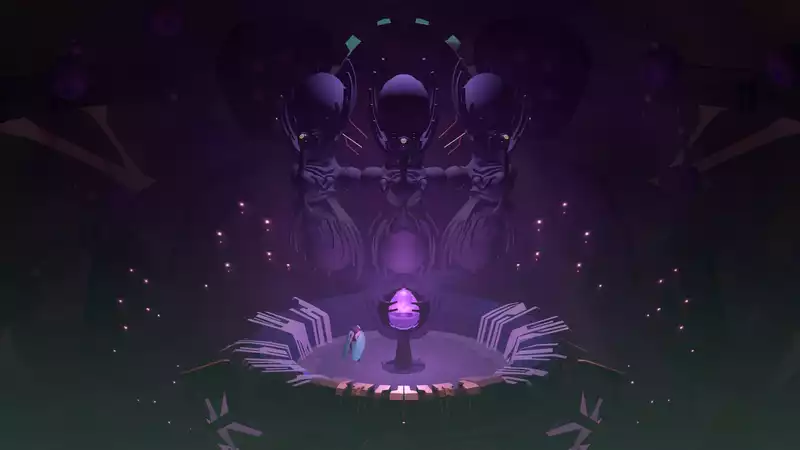Walk around the orange canyon in the opening area of the cocoon for a while, and you will find a groove in the ground that curves like a smile with indented lips. At one end is a large metal ball that, when grabbed and pulled, reluctantly detaches from its rectangular base but remains connected by a string of chewing gum. As the elasticity of the gum approaches its limit, the base begins to move as well, gliding through the mouth as if it were a zipper.
The fun of "Cocoon" as a puzzle-adventure lies in figuring out how to move through the obstacles, but also in the execution. The beetle-winged humanoid you guide can only manipulate the world with a single action button, and there is nothing else to manipulate in the immediate vicinity. Drag the zipper along the groove to activate the platform. That's it. But it is a much more enjoyable exercise than simply pulling a lever.
The tint of the ball's tinfoil, the suppleness of the gum, the pink flesh that ripples as the zipper advances. It's all very tactile.
Cocoon makes an incredible meal out of a puzzle that could have blessed the vinyl inside, with moody synthesizers in the background, in a vivid worldview that could have graced the cover of a prog album. When you are activating the bridge here, you are not simply flipping a switch to activate it. Even the platform that responds to the zipper is actually a giant flat robotic bug, clawing at the canyon walls. Wrapped in plastic, metal, and organic materials, the everyday concept feels both familiar and alien. It raises questions that no one seems to be able to answer.
As one moves deeper into the game, the puzzles become more intrinsic. You reach what looks like a round rubber platform in the sand, press the action button to activate it, and watch as the beetle jumps up and out of the world itself. You are now in a gray industrial area. The world you were in earlier only exists here as a large orange marble. When you interact with this marble, you can move around with it on your back, like an ant with a seed.
This orb world functions as a kind of power cell in the new environment. Placing it on a small pedestal causes a bone bridge to appear or a smooth plastic platform to be summoned. Using a particular pedestal, you can return to the original orange planet. After a few warps, you may find a way to move obstacles on one world with tricks from the other.
And this is only the beginning. Once you have two, three, or four orbs, each with its own world, the possibilities expand exponentially.
In some sequences, you remain in one world for a while, moving forward without regard to its place in the grand scheme of things. This is because each fresh biome reveals what form of machine inhabits what form of organism, and how the two function together in choreographed steps. For example, orange solidifies an invisible passage in the aura, creating a new pathway into the gray world and later a marshy green world, but only when it holds the orb.
Ultimately, frequent world-hopping is necessary, and "Cocoon" pushes the concept to an excellent conclusion. What if, for example, when you need to carry an orange orb, you are taken to a place where you need a green orb? What if you could hide the green in the orange world and then retrieve it when you reach your destination? "It may take a few minutes for each concept to mesh well, but Cocoon builds iteratively so you don't go off the beaten path too far. The puzzles are clever but not complicated, endlessly strange but logical, and before you know it, you find yourself dealing with physical paradoxes as a matter of course.
Sometimes you have to backtrack a bit to find what you need or think a little broader. But never get overwhelmed or lost.
What makes globe-jumping truly fascinating is not just because the puzzles are inventive and orderly. One moment your entire world becomes a mere object, the next. It is a playful expression of the scale of the universe, in which the giant objects of the planets are mere marbles in a cosmic context, an expression of interlocking ecosystems that can only function in harmony with one another. All of these marbles are essential to life, and you are another part of that whole.
Cocoon never lets up on its spectacular audiovisual design, providing a lush environment for puzzles. Puzzles that don't make sense become perfectly understandable as you play with them. The kaleidoscopic architecture blends the natural landscape into the cellular structure. Pillars protrude from the ground at such narrow intervals that you can pass through but not the trolley, like the bars on an airport escalator. Fields of lollipop plants wobble and sway like rubbery mushrooms. The transports surround you with crank-click precision, and you realize they resemble giant jam sandwich cookies.
"Cocoon" is a game of puzzle textures, but rarely has a puzzle felt as good as this one.
.

Comments